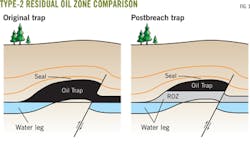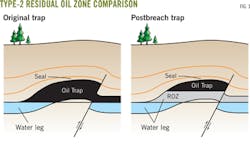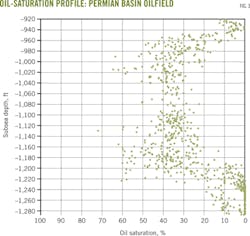Permian basin production proves ROZ viability
Abdallah Harouaka
Bob Trentham
University of Texas, Permian Basin
Odessa
Steve Melzer
Melzer Consulting
Midland, Tex.
Permian basin operators are re-evaluating residual oil zones (ROZs) as viable targets for tertiary oil recovery, generally through CO2 injection. Several pilots and full-field applications are under way to evaluate these long-overlooked resources.
This article explains how ROZs are formed and how they increase the thickness and lateral extent of an oil field and what specific Permian operations are proving that ROZ are both technically and economically viable.
ROZ formation
ROZs are a natural part of original (paleo) oil traps. Over geological time they underwent natural waterflooding. They subsequently became a separate, distant greenfield accumulation or an integral part of a brownfield's aquifer.1-5
In both cases, capillary pressure and fluid distribution become complex, making recoverable volumes difficult to assess. Operators have historically avoided ROZs despite evidence that oil is present.5-8
There are three types of late-stage base tectonics affecting oil fields in which ROZs are formed:
1. Fields that were subject to regional tilt.
2. Fields with breached and repaired seals.
3. Fields where hydrodynamic conditions have changed with an oil-water-contact (OWC) tilt.
In all cases, a natural waterflood took place over millennia through very few capillaries and with either closed aquifers or aquifers refilled from the surface. These conditions affect capillary pressure and fluid distribution in ROZs.
Many oil traps have well defined oil-and-water phases at their crests. As we go deeper into the reservoir, however, we can encounter faults, edge water, or sealing. Fluid distribution becomes less clear.
Initially, oil traps extend down to the paleo OWC. At this stage, thermodynamic equilibrium exists. Below the OWC and transition zone (TZ) there is total water saturation.
As geological forces move the OWC, the lower part of an oil trap becomes open to flow. An ROZ is formed directly below the main pay zone (MPZ) as a product of natural waterflooding or is flushed away from the MPZ to form a separate greenfield accumulation.
Generally, this is a very slow process. Analytical modeling shows the pace to be on the order of 1 ft/1,000 years.7 This flushing continues for about 20 pore volumes until the residual-oil saturation is optimized and is not mobilized by natural processes.9
Without a choked-flow system, ROZs are formed with poor sweep efficiency through preferential pathways, making fluid distribution difficult to predict. By looking at the results of unchoked, man-made waterfloods in MPZs, however, we get a good indication of the fluid distribution in the ROZs beneath.
Conventional waterfloods in clastic rocks leave behind as much as 50% of the original oil in place and the percentage is even greater in non-clastic rocks. Therefore, one would expect high oil saturation in ROZ.
Oil saturation
Fig. 1 illustrates an oilfield with a breached and repaired seal (Type-2 ROZ), showing how the lower part of an oil trap is transformed into an ROZ through waterflooding from the aquifer below. This figure suggests a bottom-water drive, although edge-water drives can also be encountered. There can also be either full or partial aquifer-reservoir contact.
The volume of water invading the lower part of an oil trap can be calculated. As stated previously, volumetric-sweep efficiency is difficult to predict with any certainty because the invading water pattern is largely unknown. Conformance can also be poor.
These factors explain erratic oil-saturation distributions in ROZs. Core samples, single-well chemical-tracer tests, and inject-log tests of carbonate reservoir ROZs show a wide distribution of oil saturation, both laterally and vertically.6 The saturation distribution does not correlate with depth, porosity, or permeability.
Capillary (vertical) equilibrium between the main reservoir or MPZ and the ROZ beneath is a concern because it implies the absence of cross flow between these zones. After production begins, a "normal" capillary pressure develops in the MPZ and the transition zone (Fig. 2).
Flow through the ROZ upward (or edgeward) during its formation is two-phase until the residual-oil saturation is reached. Oil saturation below the transition zone can be erratic and depends heavily on the type of aquifer and ROZ (Fig. 2).
Studies of wells in Seminole (San Andres) field have demonstrated the contrast of ROZ oil-saturation profiles.8 This research demonstrates that Seminole is quite different in its vertical profile character where a thick middle zone of nearly constant oil saturation is present.
Seminole oil traps have tilted OWCs, implying current hydrodynamic forces are at work. Horizontal water influx and oil flushing explains both the tilt and the thick ROZ profile.
Most ROZs studied so far were discovered beneath mature oil fields. Well extensions and core samples below the producing OWC have shown promising oil saturation. A recent study investigated core-derived oil saturation for a large Permian basin field.7 Fig. 3 illustrates the saturation intervals of the gas cap, MPZ, ROZ, and the aquifer beneath this field.
Permian basin ROZs
The Permian basin has proven that ROZs can be tapped for large oil resources, specifically through CO2 injection (OGJ, Apr. 7, 2014, p.66). Based on available geologic information, documented OWC tilts, and log-based data, a number of major oil reservoirs with ROZs were established in five major Permian basin oil plays:7 8
• Northern Shelf Permian basin: San Andres carbonate formation.
• North Central basin platform: San Andres, Grayburg carbonate formation.
• South Central basin Platform: San Andres, Grayburg carbonate formation.
• Horseshoe Atoll: Canyon and Cisco carbonate formations.
• Eastern New Mexico: San Andres carbonate formation.
Table 1 describes the TZ, ROZ, and original oil in place in these five plays. The Permian basin (San Andres) is the only region in the world exploiting oil below the OWC.8 That may soon be changing, however.
Potential ROZ exploitation
We are beginning to see increased ROZ investigation throughout North America in areas that have the geological prerequisites:
Williston basin, which extends over the Dakotas, Montana, Manitoba, and Saskatchewan, is reported to have all of the ingredients, including a tilted OWC, for the presence of ROZ.5 10
Big Horn basin,8 the Western Anadarko basin,11 and the San Joaquin basin8 all show similar potential.
The list is only a partial list, meant to give some insight into the possible scope of ROZ exploitation. Another means of demonstrating current success is to look at CO2 injection.
Permian CO2 injection
CO2 injection is the preferred enhanced oil recovery (EOR) process in the Permian basin where many identified ROZs are currently benefitting from it. An expanding CO2-EOR project targeting the ROZ has been carried out in Salt Creek field by ExxonMobil Corp. involving 36 wells and incremental production of 2,000 b/d.7
There are several CO2-EOR pilot tests. Two are operated by Occidental Petroleum Corp. in the Denver and Bennett Ranch units of the giant Wasson oilfield. Another two are operated by Hess Corp. in the Seminole San Andres unit mentioned previously.
Table 2 lists ongoing and planned ROZ CO2 EOR projects in the Permian basin. These projects not only lead to increased hydrocarbon production increase, they also lead to the sequestration and reduction of large volumes of CO2.12
References
1. Melzer, S., "Stranded Oil in the Residual Zone," US Department of Energy Report, February 2006.
2. Brown, A., "Effects of Hydrodynamics on Cenozoic Oil Migration, Wasson Field Area, Northwestern Shelf of the Permian Basin," West Texas Geological Society Fall Symposium, October 2001, pp. 133-142.
3. Ghauri, W.K., Osborne, A.F., and Magnuson, W.L., "Changing Concepts in Carbonate Waterflooding, West Texas Denver Unit Project - an Illustrative Example," SPE, American Institute of Mining and Metallurgical Engineers, Permian Basin Oil and Gas Recovery Conference, Dallas, [dates]1976.
4. Lindsay, R.F., "Meteoric Recharge, Displacement of Oil Columns and Development of Residual Oil Intervals in the Permian Basin," West Texas Geological Society Fall Symposium, Oct. [dates], 2001.
5. Koperna, J.G., L.S. Melzer, and V.A. Kuuskraa," Recovery of Oil Resources from the Residual and Transitional Oil Zones of the Permian Basin," SPE Annual Technical Conference and Exhibition, San Antonio, Sept. 24-27, 2006.
6. Wachtman, R.J., Pathak, P., Fitz, D.E., Meissner, J., and Lizbeth Guijarro, "Means Field Residual Oil Zone Study - Extending the Life of a 75-Year-Old Field," AAPG, PSE, SEG Hedberg Coinference: Fundamental Controls on Flow in Carbonates, Saint Cyr Sur Mer, France, July 8-13, 2012.
7. Trentham, B., "Residual Oil Zones (ROZ's) and the Long-Term Future of the Permian Basin (and Elsewhere)," SPE Permian Basin Study Group of Gulf Coast Section, Apr. 4, 2011.
8. Meltzer, S., "Residual Oil Zones in the Permian Basin: Exploiting Mother Nature's Waterfloods and Rethinking the Concept of Transition Zones," RPSEA Onshore Production Conference: Technological Keys to Enhance production Operations, Midland, Tex., Apr. 10, 2012.
9. Hubbert, M.K., "Entrapment of Petroleum Under Hydrodynamic Conditions," American Association of Petro-Geologists (AAPG) Bulletin, Vol. 37, No. 8, August 1953, pp. 1954-2028.
10. Berg, R., DeMis, W., and Mitsdarffer, A., "Hydrodynamic Effects on Mission Canyon (Mississippian) Oil Accumulations, Billings Nose Area, North Dakota," AAPG Bulletin, April 1994, Vol. 78, No. 4, pp. 501-518.
11. Sorenson, R.P., "A Dynamic Model for the Permian Panhandle and Hugoton Fields, Western Anadarko Basin," AAPG Bulletin, July, 2005, Vol. 89, No. 7, pp. 921-938.
12. Ming. C.M., and Melzer, L.S., "CO2 EOR: A Model for Significant Carbon Reductions," Symposium on the Role of EOR in Accelerating the Deployment of CCS, Massachusetts Institute of Technology, Cambridge, July 23, 2010.
The authors
Abdallah Harouaka ([email protected]) is professor and program coordinator of petroleum engineering at the University of Texas, Permian Basin. He holds a BS in mathematics from New Mexico Tech and an MS and PhD in petroleum and natural gas engineering from Penn State University. He is a registered professional engineer in Texas and a member of SPE.
Bob Trentham ([email protected]) is the director of the Center for Energy and Economic Diversification and Senior Lecturer in Geology at the University of Texas, Permian Basin. He holds a BS and MA in geology from the City College of New York and a DGS in geology from the University of Texas, El Paso. He is a member of the AAPG, SEPM, WTGS, and PBS SEPM.
Steve Melzer ([email protected]) is an enhanced-oil-recovery consultant in Midland, Tex. He holds a BS in geological engineering from Texas A&M University and an MSE in civil engineering and rock mechanics from Purdue University. He is a registered professional engineer in Texas and a member of AAPG and SPE.





